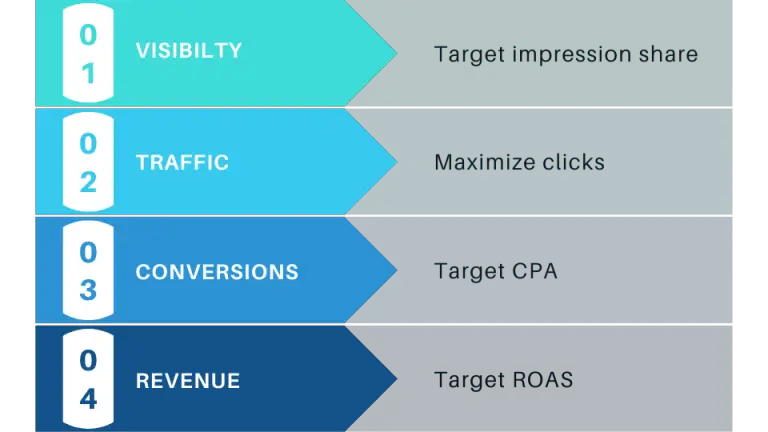Match each Google Ads autobidding strategy to the right campaign goal
The table below details which autobidding strategy matches best with each campaign goal.
- Visibility – Target impression share
- Traffic – Maximize clicks
- Conversions – Target CPA
- Revenue – Target ROAS

It is important to match each autobidding strategy to the right campaign goal to maximize your advertising spend. Contradicting bidding strategies confuse the algorithm and hinder your campaign from getting the best possible results.
What can automated bidding help an advertiser improve
Google Ads autobidding can be a great way to automate your bid management. But it’s important to make sure you’re using the right strategy for your campaign goals. Otherwise, you could end up wasting your ad budget or not reaching your full potential. Use the table above to help you choose the right autobidding strategy for your next campaign.
What are the different Google Ads autobidding strategies?
- Target impression share
- Maximize clicks
- Target CPA
- Target ROAS
What are the different Google Ads campaign goals?
- Visibility
- Traffic
- Conversions
- Revenue
How to choose the right autobidding strategy for your campaign goal
There are many different autobidding strategies that you can use in Google Ads. It’s important to understand and choose the right one for your campaign goal.
- If your goal is visibility, then you should use the target impression share autobidding strategy.
- If your goal is traffic, then you should use the maximize clicks autobidding strategy.
- If your goal is conversions, then you should use the target CPA autobidding strategy.
- If your goal is revenue, then you should use the target ROAS autobidding strategy
Manuel vs automated bidding in Google Ads
There are many different types of bidding in Google Ads. You can choose between manual bidding or automated bidding. Manuel bidding is when you, the advertiser, sets the maximum CPC for each individual keyword. Automated bidding is when Google Ads sets the CPC for you based on your campaign goals.
Read our beginners guide: Real Time Bidding 101.
What are the benefits of manual bidding?
- You have more control over your CPC
- You can optimize your campaigns targeted on the keyword level
- You can better target your audience
What are the benefits of automated bidding?
- It’s easier and faster
- You don’t have to worry about setting a CPC for each individual keyword
- Google will set your CPC based on your campaign goals
So, which type of bidding should you use?
It really depends on your campaign goals and your level of expertise. If you’re just starting out, then automated bidding might be the better option. But if you’re more experienced, and you have a good understanding of your target audience, manual bidding could be the way to go.
In general, manual bidding gives you more control over your CPC and allows you to optimize your Google Ads campaigns more targeted. Automated bidding is easier and faster, but you don’t have as much control over your CPC. Ultimately, it’s up to you to decide which type of bidding is right for your Google Ads campaigns.
Advanced bid strategies
Combination of autobidding with manual limits
You can set limits or target cost per each campaign goal on the campaign and ad group level. If you have a conversion based search campaign with 3 ad groups, you can set a target CPA for the entire campaign, but also for each ad group.
Bid adjustment strategy
There are many different bid multiplier strategies that you can use in Google Ads. The most common ones are location, device, and time of day.
Location: You can adjust your bids based on the geographical location of your target audience. For example, if you’re targeting people in the United States, you might want to increase your bids for keywords that are popular in that country.
Device: You can adjust your bids based on the type of device that your target audience is using. For example, if you’re targeting people who are using mobile devices, you might want to increase your bids for keywords that are popular on mobile devices.
Time of day: You can day-part your bids based on the time of day that your target audience is searching for keywords. For example, if you’re targeting people who are searching for keywords during the evening, you might want to increase your bids for those keywords.
These are just a few of the many bid adjustment strategies that you can use in Google Ads. Ultimately, it’s up to you to decide which strategy is right for your campaign.
Matching autobidding strategies to the right campaign goal FAQs
In order to maximize Google Ads campaign performance, it is important to match each autobidding strategy to the right campaign goal. If you want to generate leads, the campaign should be fully set up to optimize for lead generation. On the other hand, if your campaign goal is to drive as much traffic as possible, you need to alter your autobidding strategy.
Advertisers should use the target impression share autobidding strategy to maximize visibility as the campaign goal. Other bidding strategies optimize the campaigns for clicks or conversions.
Automated bidding in Google Ads can help an advertiser improve several aspects of their advertising campaigns: Efficiency in Bid Management, performance improvements, time-saving, handling complex data, and ultimately achieving marketing goals and a better return on ad spend (ROAS).
Overall, automated bidding helps advertisers efficiently manage their bids, achieve their advertising goals more effectively, and optimize overall campaign performance.

Sascha is a Lifecycle Marketing Consultant with over 8 years of digital marketing experiences in Silicon Valley, the UK, and Germany.
After leading the demand generation for a 100+ million company, he decided to venture out on himself. He’s now helping clients to attract and convert more leads and customers.
His main focus are SEO, paid media & marketing automation – all with the focus to tie marketing campaigns to revenue.
Sascha has been featured in industry publications.



